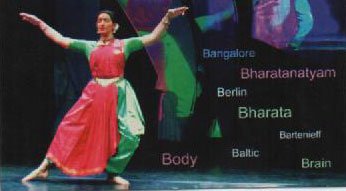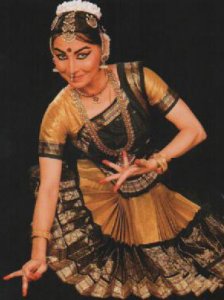
|   |

|   |
Indian dance in a global age - East and West meet in Berlin - Ashish Mohan Khokar e-mail: khokar1960@gmail.com July 2, 2013 The Freie University (FU) is among the world’s top ten. Its dance and theatre research department is recognized as having a cutting edge approach even in the Western world. Prof. Dr. Erika Fischer-Lichte and Prof. Dr. Gabriele Brandstetter head its International Research Centre (IRC) as Directors. Both bring vast experience and expertise in their fields to the table, oops The Green Table (no discourtesy to Kurt Joos). FU means the Free University (English for Freie Universität) and was set up when Berlin was partitioned into East and West and the famous Humboldt University went to East. Rudyard Kipling may have said, “East is East, and West is West, and never the twain shall meet, Till Earth and Sky stand presently at God’s great Judgment Seat….”, but the two Berlins did meet and are now one and the Free University is a symbol of past corrections and future possibilities. The IRC’s ‘Interweaving Performance Cultures’ (now in its fifth year and second term) was a pilot project to study interweaving of cultural performances. Its programs and participants, drawn from the world over, have contributed significantly in the process. Selected from many countries, its Fellows are distinguished names in the field. FU/IRC is a case study for Indian dance and theatre-specific university departments, forever living in the past, without much dynamic debate or discourse. While we have had many universities like Baroda and Bombay, Bangalore and Delhi, except perhaps for the Jawaharlal Nehru University (JNU, whose Arts and Aesthetics department was a non-starter in the mid 80s, when it was started and soon closed down), few university departments are dynamic enough to note current trends and discourses taking place worldwide. Part reason ascribed to this approach and attitude is that there is enough to unravel in our own histories in India - a country the size of Europe - with as many States and cultures. It is only of late that Indians, who have won some international repute like Dr. Rustom Bharucha and Dr. Avanthi Meduri, are involved in responsible positions (JNU and FU) and may someday become catalysts of change.  Rajyashree Ramesh
Berlin and Bharatanatyam have had in common Rajyashree Ramesh, who has
taught the form for 30 years and continues to enrich the landscape with
her dedication and devotion to the form. Her latest disciple is Eva
Isolde Balzer who had her arangetram (professional debut) on June 22
preceding the 2 day symposium on Indian Dance in a Global Age.
First-rate training and impeccable foundation makes Eva’s dance a
delight, although hard foot thumping and faulty laya-tala
(tempo-rhythmic ability) made it less than perfect. On two
occasions the able mridangist from Bangalore, Pratap, covered up for
her. Her singer musician husband Manickam Yogeswaran from Sri Lanka,
fondly called Mr. Yoga, sang ably with a live orchestra drawn from
London, France and Berlin. His music was soulful and he is a humble
man.  Eva Isolde
Balzer
Day 2 of the Symposium was at the Indian Embassy and was opened by Dr. H.S. Shivprakash of the ICCR’s Tagore Centre. He had an overview which was vast and philosophical. Next, Prof. Dr. Gabriele Brandstetter’s Keynote Address showcased several key issues and new prisms for dance research. Dr. Phillip Zarrilli put his theatre voice to good use to showcase the work of two Indian dancers. Prof. Martin Puttke, a leading Ballet pedagogue, proved his point about the dance body’s centre very ably with clear examples and demonstrations. Dr. Sandra Chatterjee proved to be a worthy researcher from the young constituency, where the median age was perhaps 60! Rajyashree Ramesh shared her long struggle in establishing a traditional Indian form like Bharatanatyam in Berlin. By the time the last speaker, a neuroscientist (Anja Webber) walked on stage with the model of a brain in hand, most of us were brain dead! So much to see and absorb and learn in so few hours. Her deeply researched scientific study on the brain and dance therapy made for a new angle of learning. Dr. Avanti Meduri put together this whole symposium with purpose and flair. A dancer, playwright, pedagogist, scholar of international repute, she helped structure the content and context of this two day symposium. The symposium showed her inclusivity and outreach. About twenty years ago, I too had discussed with the same guide, Dr. Richard Schchener, about my undertaking a Ph. D at NYU, but my father’s (and father-figure of Indian dance history, hence the mention here) cancer then did not make it possible for me to be out of India for long periods. I got my “Ph. D” at home, by recording him for hundreds of hours on tape, by learning first-hand the histories of many artistes and how forms had grown and evolved. This helped me in our quest for saving the Khokar Collection on Indian dance and heritage (dancearchivesofindia.com). In retrospect, the methodology of an NYU or FU type of experience would have enhanced my learning process. Tagore Centre’s head Prof. Dr. H.S. Shivprakash is himself a theatre expert from Bangalore, on lien and loan from his teaching position at the JNU, currently posted at Berlin. Representing ICCR, which had sponsored my trip to the land of Max Mueller, he played a good host and his use of appropriate Sanskrit verses and interjections showed his vast canvas. Dr. Shivprakash released attendance and handed the first copy to Dr. Erika Fischer-Lichte. His presence on both the days of the symposium showed his involvement with the university and arts scene. Reputed dance critic, scholar, historian and dance academic, Bangalore-based Ashish Mohan Khokar edits and publishes India’s only yearbook on dance - attendance - now in its 15th year. He has helped mentor young upcoming artists by giving them a platform and awards through the Dance History Society of India, which he chairs. His Dance DISCourse series is an academic interactive dance forum, in collaboration with the Alliance Francaise de Bangalore. He is the curator of the Mohan Khokar Dance Collection. For more details: attendance-india.com |